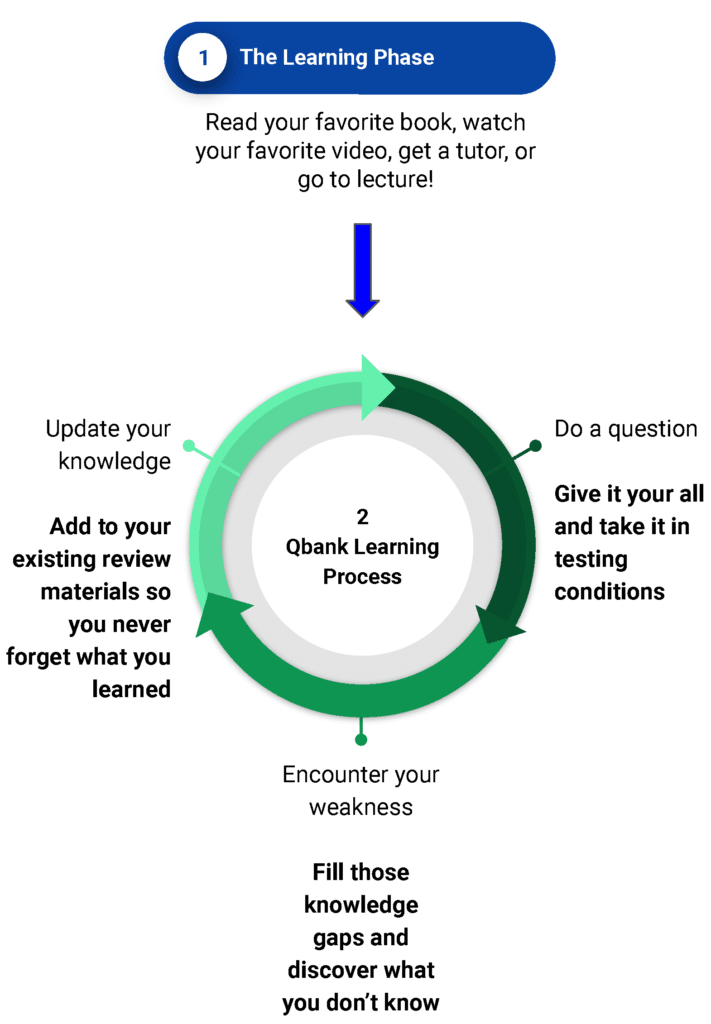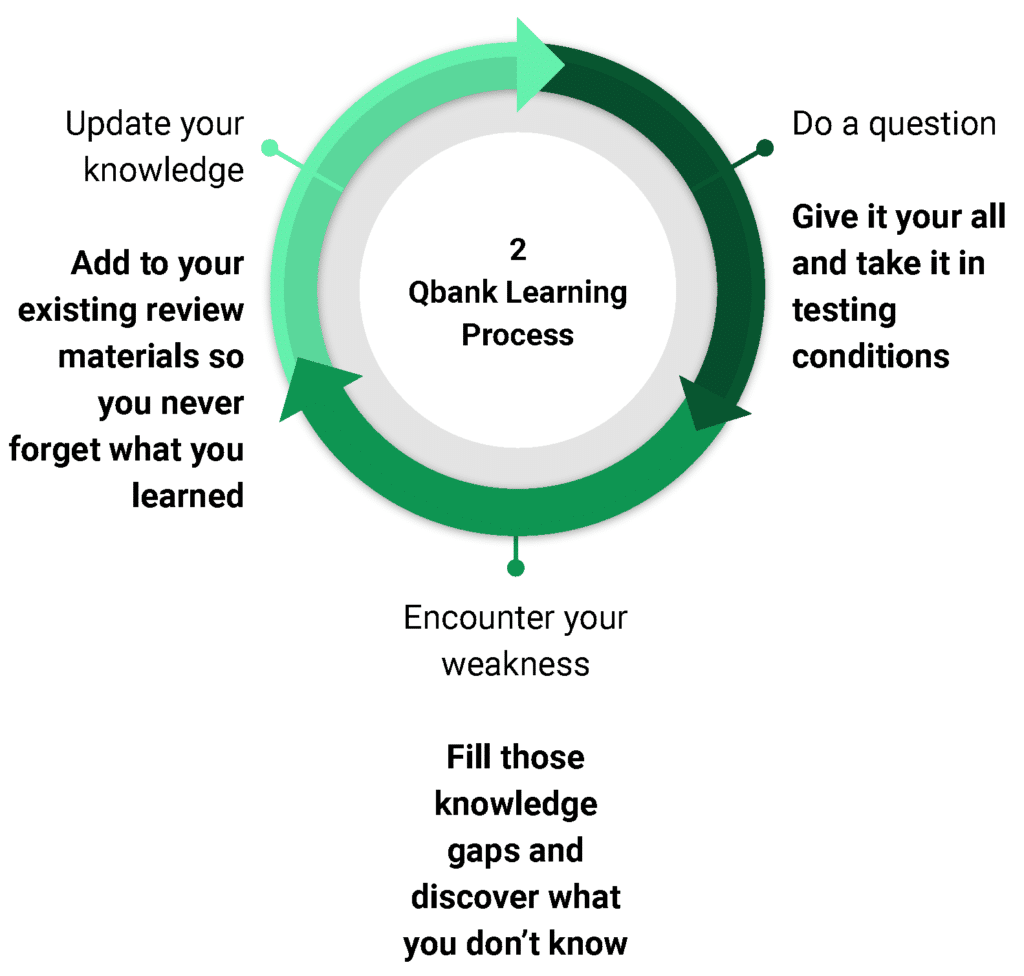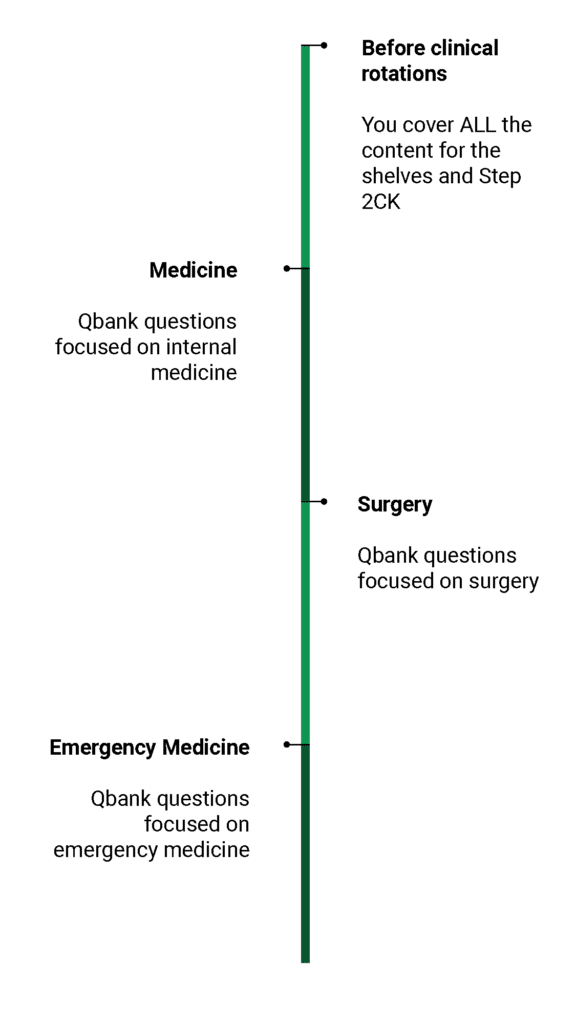How to Use and Incorporate a Qbank While Studying for Shelf Exams & Step 2

The best way to learn medical content is to have real patient encounters that expose you to a real person with an emotional connection to the case, workup, and outcomes. This is why the clinical year of medical school exists, so you can begin to encounter patients and hopefully continue this learning throughout residency. However, medical students are also expected to know a broad spectrum of conditions—from common to exotic ones—and will certainly not have a real patient encounter for every pathology they are expected to know. This is where case-based learning and question banks (Qbanks) come into play.
A Quality Qbank Is Your Best Asset for Learning In Medical School
There are a few different ways to use a shelf exam Qbank depending on the learner, their background knowledge, and how they engage with the material. Studying usually distills down to three key phases: the learning phase, the application phase, and active reviewing (more of a continuous phase).
Today, we will focus on the application phase. While there are many right ways to use a Qbank, there are also many wrong ways to use them. I’ve broken down a few approaches.
3 Approaches to Qbank Studying
1. The Steady Learner: The Classic Approach
One of the best ways to use a Qbank is to first encounter or learn the material through your favorite reference, whether this is a textbook, video series, lecture, or private tutor. This creates awareness and lays the groundwork for applying your knowledge for the next phase of learning. You’ll do this on a rotation-by-rotation basis.
Once you have this fundamental knowledge, it’s time to put your knowledge to the test with a Qbank. Remember, you’re training to both see patients while under time constraints and to take an important standardized test under strict time constraints, so these blocks need to be timed and reflect testing conditions.
In this phase, you’ll be doing nonstop questions where you constantly test your knowledge to see if you can recognize and manage different pathologies in the many different facets they may present. This is where you discover the “unknown unknowns,” or the things that you don’t know you don’t know.
Here’s what the process ends up looking like:

Remember, practice makes perfect, so doing a lot of questions to test yourself is the key to improving.
Suggestions for the Classic Approach:
- Remember to move on from preparing or learning material
Spending too much time reading different resources, watching all the video series, or constantly trying to passively learn by merely encountering the material will result in lower scores. Remember, every additional reference you try to add means more time spent passively learning versus actively attacking your knowledge and improving it with a Qbank. Find the right balance, but remember: questions beat out passive reviewing almost every time.
- Use the Qbank in timed, test-taking mode
While it’s more stressful to do questions in a timed exam mode, remember you’re training to take a test under these conditions. Be sure to practice in exam mode! This is not the slow learning phase but is rather one of your first steps into active learning and challenging yourself.
- Make sure you aren’t being too thorough
This may sound odd—how can you be too thorough? Some medical students may spend too much time reviewing questions and perfecting their knowledge, only to find out that an entire day of studying has led to only covering a few subjects. Set a pace and balance being thorough with accomplishing your goals and getting through the questions you need to get done that day.
2. The Speedy Learner: A “Dive Right In” Approach
Another type of student prefers to learn only through doing questions and dives right in on day one with case-based learning.
There are benefits and drawbacks to this strategy, and you have to be honest with yourself whether this is right for you. If your basic knowledge is weak and you will essentially be guessing through all the questions, then this is not the method you should use! Essentially, you are taking a Qbank, which is designed to test your knowledge, and converting it into a textbook by guessing and then reading the explanation. Don’t do this—it’s not a good use of a Qbank or your time.
On the other hand, if you have stronger fundamentals (usually someone with a higher Step 1 score), then this method could work. Essentially, you will be pushing yourself to apply your knowledge (perhaps even overextending yourself a bit with things you have not seen before) and accumulate knowledge through exposure without an initial fundamentals phase.
The benefit of this method is that it is faster—you’re skipping an entire phase of studying and learning with cases and questions and hopefully retaining it sooner. The drawback is that you may find yourself trying to answer questions you aren’t ready to answer yet.
Just like all approaches, there are benefits and drawbacks. The speedy approach is faster but may be less thorough, and you may lose the true value of a Qbank (which is meant to be a high-quality case that tests your knowledge and helps you improve upon it).
Thus, this method looks like this:

Suggestions for the Speedy Approach:
- Be honest with yourself when it doesn’t work
If you know you don’t have strong fundamentals, try learning the material first—even briefly—before testing yourself.
- Be thorough
Since you’re skipping the learning phase, it’s important to pull out all the useful information from the explanation and not be too terse with review.
- Be patient
Doing questions is fun, but always pull yourself back in if your scores are too low and you don’t have a clue how to approach the question. It might be time to pause and learn some of the fundamentals first.
- Be open to doing more questions
You may need to do more questions with this method than other students do, given it’s your primary method of learning.
3. The Cumulative Learner: A Thorough Approach
This is a unique style of learning that works very well for many students but takes a bit of ground work. You may need to begin studying for Step 2CK and the shelves before your clinical year/rotations begin. This approach takes grit, determination, and willpower but pays off in the end.
With this approach, you first go through all the material for Step 2CK and the shelves, creating notes and review materials that you will review throughout the year without doing questions in between. This allows you to see the full spectrum of information that you will encounter and get the bigger picture of the clinical year. Note that this is generally done before the clinical year even begins.
Once you have completed this first pass through the material, you will have a foundation for both Step 2CK and the shelves and then will embark on Qbanks. Essentially, the rest of your year will be spent doing questions and testing your knowledge.
Suggestions for the Thorough Approach:
- Push through when it becomes tedious
Many students can’t study for too long without some excitement, patient encounters, and Qbank questions. Determination is key, and you have to enjoy the process of getting through all the material. If you just quickly and passively get through the material, then your study time is wasted.
- Keep up with targeted review throughout the year
This will keep your knowledge up to par and ensure you don’t forget what you’ve learned. As the year goes on, you’ll find each rotation gets easier and easier as you’ve been reviewing that material all year long. Stay disciplined and keep up to date on reviewing!
- Start early
One of the key benefits of this approach is by starting early and covering all the material before clinical rotations, you alleviate the stress of having to learn the material on that rotation and you come in much better prepared and ready to begin testing your knowledge on day one of each rotation. Most medical students don’t want to start studying before the year even begins, but it will pay off and you will thank yourself down the road if you do!
If you can muster it and are willing to start early, I highly recommend giving this approach a try, as it leads to great success. Here’s what this process essentially looks like:

Maximizing the Qbank
I can’t emphasize it enough: active learning beats passive learning every time.
You should NEVER be trying to merely get through X number of questions so you feel like you’ve done your work for the day. Set yourself goals of what you want to accomplish, but never sacrifice quality for quantity, as it will harm your scores and progress on the back end.
When reviewing a Qbank, the most important thing to do is to thoroughly review the questions you’ve done that day. Don’t let questions roll over to the next day—it’s better to do fewer questions and review them before you decide to wrap up for the night than do a ton of questions without reviewing them all.
Why? Because right after you answer a question, you have the most insight into what you were thinking when you answered it. This allows you to think through the following list, which you must be able to answer for every Qbank question you review:
- Why is the correct answer correct?
- Why did I choose a particular answer? What was my rationale, and what evidence did I use to come to the conclusion?
- What do I need to update in my understanding of the concept regardless of whether I got the answer correct or not?
- How will I not make this mistake again and add this to my targeted review so I don’t forget what I learned?
- Do I understand ALL of the incorrect answers/distractors? Why are they wrong, and what unique information do these distractors have to offer?
- Can I explain the take-home point of the question to someone else?
If you can answer all of these questions, then you’ve done a thorough job reviewing the Qbank question. Your mind is best geared to answer these questions right after you’ve finished a question block.
Note that reviewing a Qbank question is not just reading the explanation like when you read a textbook, but rather, scouring the information and comparing it to your knowledge and updating it accordingly. This is an active process during which you truly improve!
Remember, quality is better than quantity, always.
The Bottom Line
No matter what type of learner you are, you CAN’T succeed without a good Qbank. Remember, Step 2CK and the shelf exams are standardized tests meant to assess your knowledge, so you must practice high-quality standardized questions in order to get better.
Whether you do questions after first learning the material or dive right into them from day one, the more questions that you do with quality review, the higher your score will be. Stick to the basics, stay disciplined, stay dedicated, and do a ton of questions, and you will succeed on the shelf exams and Step 2CK.
Get Free Access and Join Thousands of Happy Learners
You must be logged in to post a comment.





Comments (0)